It’s 3:30 in the afternoon on August 16th, and Siena’s Piazza del Campo is already packed. The energy in the surrounding streets is electric, with locals and visitors gathered shoulder to shoulder. It’s Palio day in Siena.
Siena hosts two legendary horse races every year: the first on July 2nd, called the Palio di Provenzano, and today’s event, the Palio dell'Assunta, in honor of the Assumption of the Virgin Mary.
Since I was a little boy, the word "Palio" conjured images of something grand and almost dreamlike. I never imagined I’d witness my second Palio in just over a year. But before I dive into the excitement of the race, let me try to convey the essence of this extraordinary event.
The Palio is a historic and dramatic horse race unique to Siena, where the city's "Contrade" fiercely compete against one another. The word "Contrada" refers to a district or neighborhood, and these Contrade are the heart and soul of the Palio. Siena is home to 17 Contrade (plural; Contrada is singular).
Back in the Middle Ages, each Contrada functioned as a self-contained community with its own leadership, militia, and resources. Names like Onda (Wave), Drago (Dragon), and Selva (Forest) reflect the powerful symbols of these historic districts. Fierce rivalries have existed between them for centuries. Although Italy is now one unified country, in the past, regions and towns frequently battled for power, land, and influence. For example, Siena and Florence were rivals for centuries. Nearby towns like San Gimignano, Monteriggioni, and Volterra served as outposts during these ongoing power struggles in medieval Tuscany. So today, the race represents far more than just entertainment; it reflects the fierce competition and deep pride of Siena's neighborhoods, where ancient rivalries and a sense of belonging are relived.
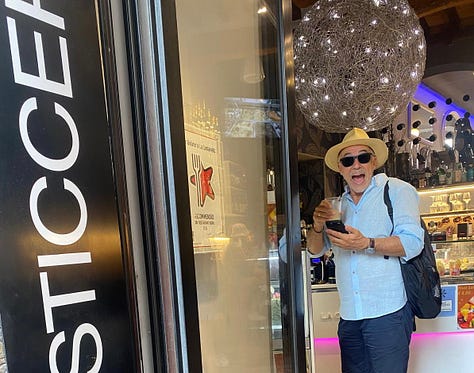
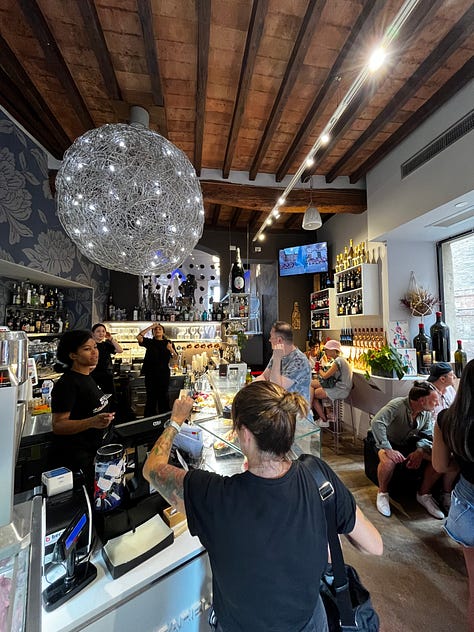
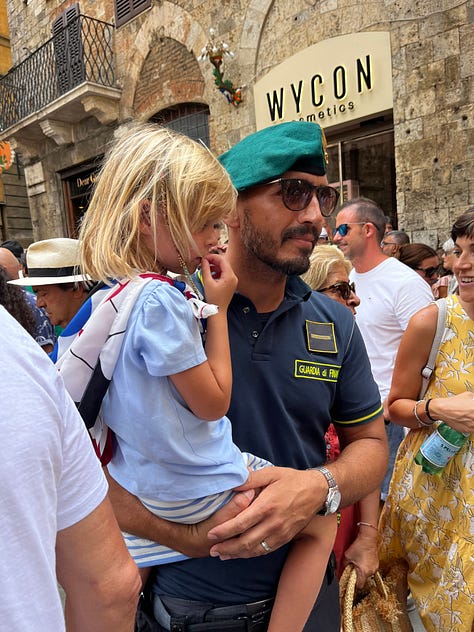

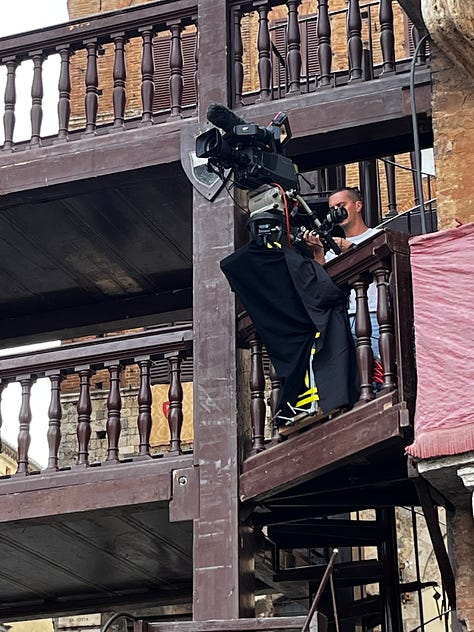
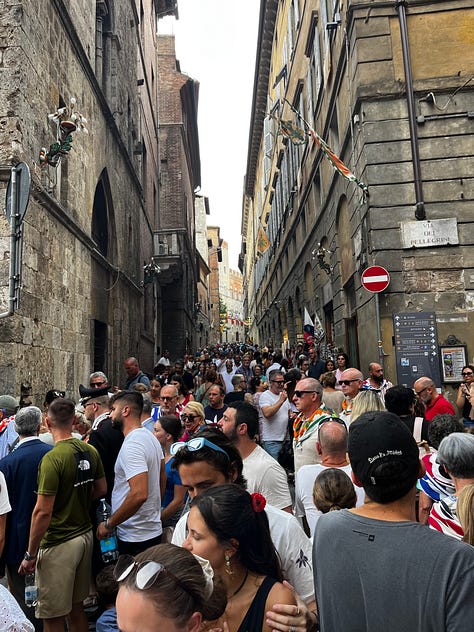
Not all Contrade participate in each race due to space and safety concerns. Although Piazza del Campo is one of the largest squares in Italy, it’s relatively small and tight for a horse race. To avoid overcrowding and minimize accidents, the city decided long ago to limit the number of horses to ten per race. Therefore, each Palio includes seven Contrade that didn’t race in the previous Palio. The remaining three spots are filled by drawing lots from the other ten Contrade that did race previously. This system ensures that every Contrada gets a chance to participate regularly.
The race is short but intensely dramatic. It consists of three laps around the piazza, and the first horse to cross the finish line, rider or no rider, claims victory. It’s all over in about 90 seconds, and the prize is the coveted “Drappellone” (A banner that is uniquely designed by a different artist and typically features religious and historical motifs). The jokey races on a bareback horse, and the sharp, perilous turns of the piazza make it as dangerous as it is thrilling.
Before the race, each competing horse is blessed in its Contrada’s church, with a priest delivering the hopeful words, "Vai e torna vincitore" ("Go, and return victorious"). This ritual, known as the “benedizione”, encapsulates the unique blend of faith and fierce rivalry that makes the Palio so special.
As the afternoon progresses, anticipation in Siena grows. The forecast predicts rain, but the crowd continues to fill the piazza. The race is never held in wet conditions, and if the rain comes, the event will be postponed until the next day. For the record, last July’s race was postponed due to rain.
My girlfriend Emi, who is originally from Siena, more precisely from the Selva Contrada, guides me through the buzzing crowds to Bar Gelateria La Costarella. Having lived through many Palio races herself, she has a deep understanding of the event, what better companion than a true Sienese to experience it with. Her deep knowledge of the Palio, shared with such clarity and passion, was invaluable, without her, it would have taken me days of research to grasp all the important details.
The bar’s prime location, backing onto the piazza, offers a front-row seat to this historic celebration. During the Palio, access to this coveted spot is reserved for those who booked months or even years in advance, with prices sometimes exceeding a thousand euros for a seat. The front section is standing room only, and this place feels more like a North American bar than a traditional Italian one, with alcohol taking precedence over coffee. The crowd is young and cosmopolitan. Siena, being a university city, draws affluent students, and this bar is one of their favorite hangouts.
On this hot day, I skip the coffee and opt for a “limonata” instead, though even that comes at a premium, three times the usual price. But then again, this bar is a landmark in Siena. As I sip my drink, I watch as the Piazza del Campo slowly transforms. The center of the square, open to all, fills up, especially around the perimeter, where spectators know they’ll have the best view of the action.
Most of the entrances to the piazza are closed early in the morning, and by the afternoon, only one remains open. This final entrance closes about an hour before the race. Once the gates are shut, no spectators are allowed in or out, except for the processions of representatives and, finally, the jockeys and their horses. Last year, I stood right in the middle of the piazza. This year, having had more than my fair share of beverages, I worry about needing to use the facilities and don’t want to be stuck there. So, we’ll try to catch a glimpse from the bar. But not before we take a stroll along the actual track, which has been covered with “tufo”, a layer of clay and sand meant to protect the horses and provide better grip than the cobblestones below. I can feel the electricity in the air as the solemn toll of the Mangia Tower’s bell echoes throughout the town.
I enjoy stepping on the soft “tufo” in this familiar place I visit often, now almost unrecognizable. We then wander down the narrow streets behind the Duomo, just in time to catch the beginning of the procession of the “Alfieri” (flag bearers) and “Compari” (comrades). Each Contrada has its own distinctive, colorful, medieval-inspired costumes, and they march to their own drumbeats, which residents can easily recognize. I can identify Selva’s beat, as I used to hear the practice drums around 5 p.m. while sitting on Emi’s terrace in the heart of her Contrada.
I take great pleasure in watching the procession as each Contrada flocks together, parading down the winding exit of the Prefettura building. The rich colors and intricate details of their costumes make it feel like stepping back in time. As I follow the procession back to the piazza, I feel raindrops on my head, and umbrellas begin to pop up. This is not a good sign, as rain threatens to dampen the festivities. We return to the bar, sipping glasses of prosecco, hoping the light rain will pass. But in vain, the Palio is postponed for today.

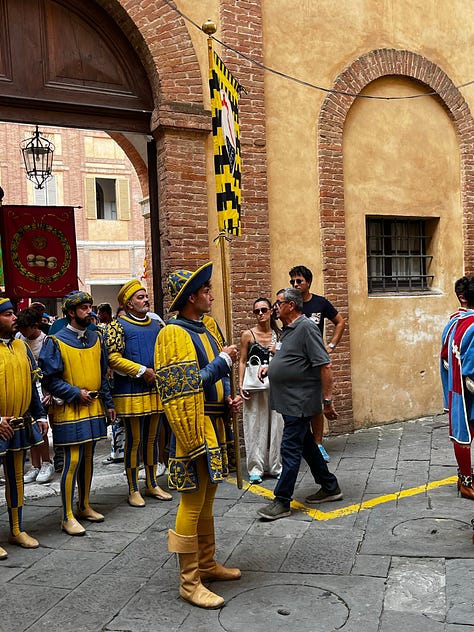

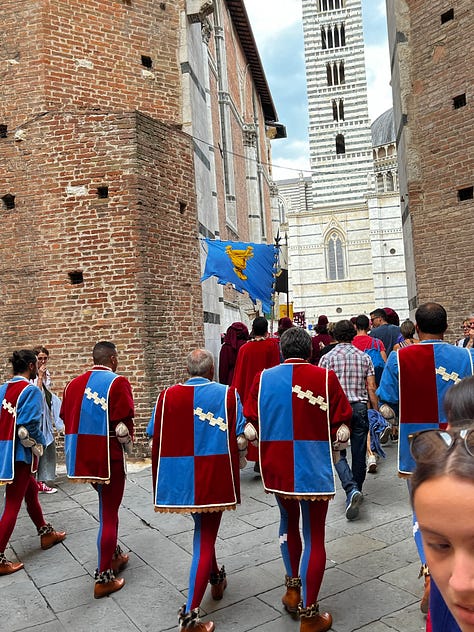

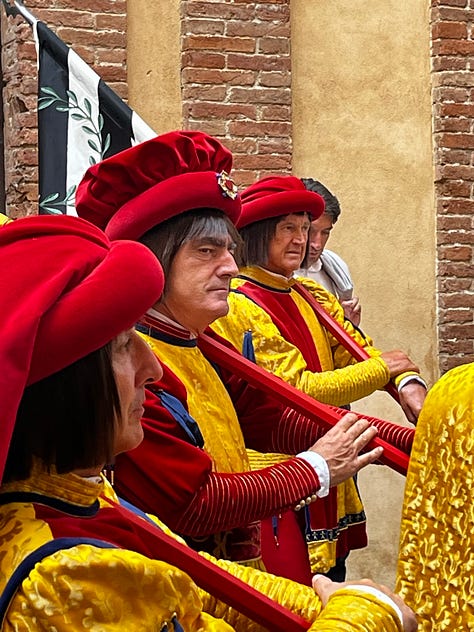
This is only the second time in history that both races in a single year have been postponed due to rain. How unusual. This summer, we’ve only had three days of rain, and two of them fell on Palio days. I heard that the Oca Contrada’s horse is injured, and perhaps the gods are with them, giving it time to heal. Oca holds the most “Drappelloni” of all the Contrade—the Wayne Gretzky of the Palio.
Although the race is off, my memories of last year’s Palio are still vivid, and I’ll share how it unfolded.
Squeezed among 60,000 spectators, Emi and I waited anxiously for the race to start. The horses were lined up in front of the “canape”, nervously awaiting the signal from the jockeys. I expected a gunshot or a rope drop, but all I saw was frenetic confusion among the riders. After what felt like an eternity, I asked her, "What's going on? Why aren’t they starting? Is there a problem?" She replied, "No, no, tutto in ordine. La partenza non la dà un dirigente ma uno dei corridori, e il Mossiere." ("No, everything’s fine. The start is decided by one of the jockeys and the Mossiere.") I replied, "Mi sembrava che sarebbe stato troppo facile dare un semplice colpo d’invia." ("It seemed to me that it would have been too easy to give a simple starting signal.") Of course, I said to her, it’s typical Italian style! What should be simple must be made complex; simplicity would be too boring, right? And with her usual Italian vivacity, she replied, "You North Americans don’t have a clue about traditions and passion! Every other race in the world is started by the lowering of a rope or lifting of a barrier. Do you want it to be like all the others? Huh? Do you?" She emphasized, "You are in Siena, at the Palio. P-A-L-I-O!" Stretching out each vowel as she said it. "And if Selva wins, I will party all night."
"And if you lose?" I asked.
"Well, I'll still get a good stiff drink," she replied with a grin.
In essence, the horses and jockeys line up between two ropes in an order determined the night before. One horse, called the “rincorsa”, stays outside and behind the starting area (behind the second rope) dictating when the race begins by choosing the perfect moment to enter. The “Mossiere”, an official staff member, ensures that the horses are properly aligned and drops the ropes to start the race. False starts are common as jockeys jostle for position, and once the race begins, almost any tactic is fair game.
In this case, we waited 45 minutes for the race to actually start. For me, it felt like an eternity. For the locals, this was just part of the experience. From that point on, everything was pure emotion. Months of buildup culminated in that moment. People were screaming and swearing (if you listen closely to videos of the race, you’ll probably hear some familiar Italian curse words). I almost forgot about the horses furiously galloping by, as I was in awe of the crowd's passionate reactions.
On the second curve of the third lap, Selva’s horse hit the padded wall, sending the jockey tumbling to the ground. The now riderless horse sped up, overtaking the others and crossing the finish line, securing victory for Selva. The crowd rushed onto the track, and the victorious horse was soon escorted away by Selva’s team. A little girl sitting on her father’s shoulders, wearing a colorful orange, green, and white Selva scarf, erupted into tears of joy as her Contrada won the race. And this is how, generation after generation, the tradition is carried on.
It was a sea of laughter, tears, and cries of bitter defeat. You don’t need to be Sienese to feel it, the energy is contagious, and you become one of them instantly.
We followed the procession to the church of Madonna di Provenzano for the ritual blessings. The horse, being the hero, is part of the celebrations. People feed him treats and put flowers on his back. We then made our way to the Selva district, where hundreds were already sitting in rows of tables chanting traditional songs. We sat and enjoyed the party until fireworks lit the skies. The victorious Contrada is granted the right to party for an entire month with feasts, music, and singing. For others, particularly those who came close to winning, the loss is deeply felt. But already, they are dreaming of next year.
As we walked back home, passing by San Domenico Basilica, we could see the skyline of this magnificent town that envelops you in time, and time will never change her.
NOTE: The Lupa (She-wolf) Contrada won the Madonna Assunta Palio the following day. The jockey Dino Pes, known as Velluto, rode the horse Benitos to victory.
Arrivederci until next Saturday—always observing, always sharing, always sipping, always a tale from an Italian coffee bar.




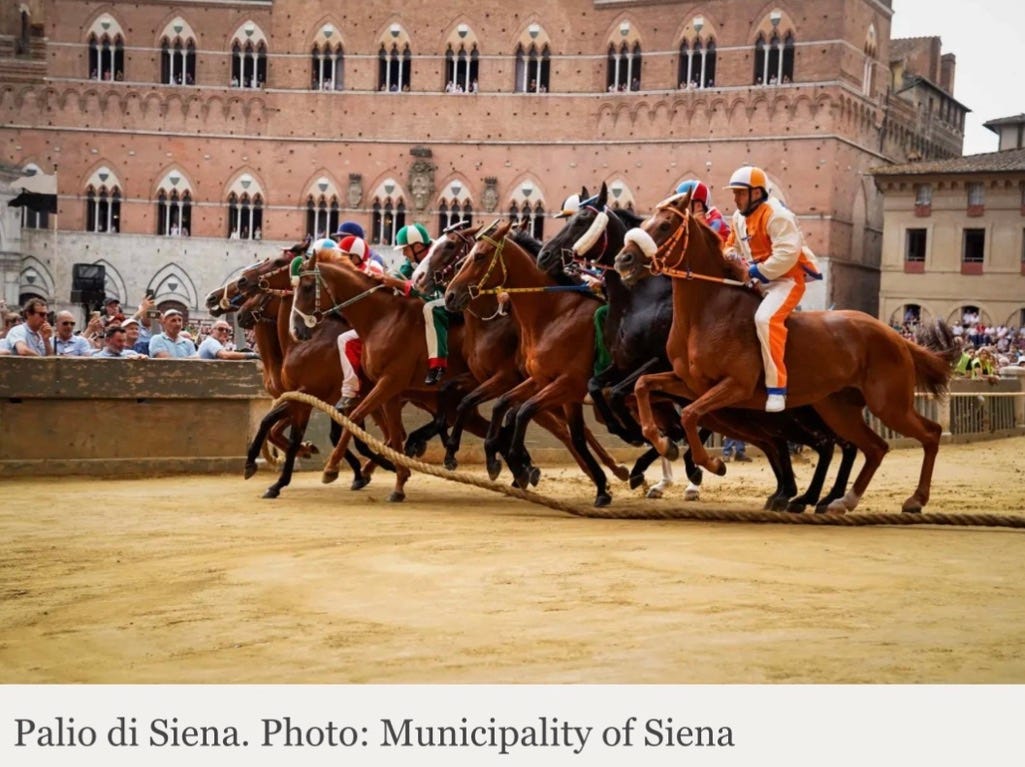

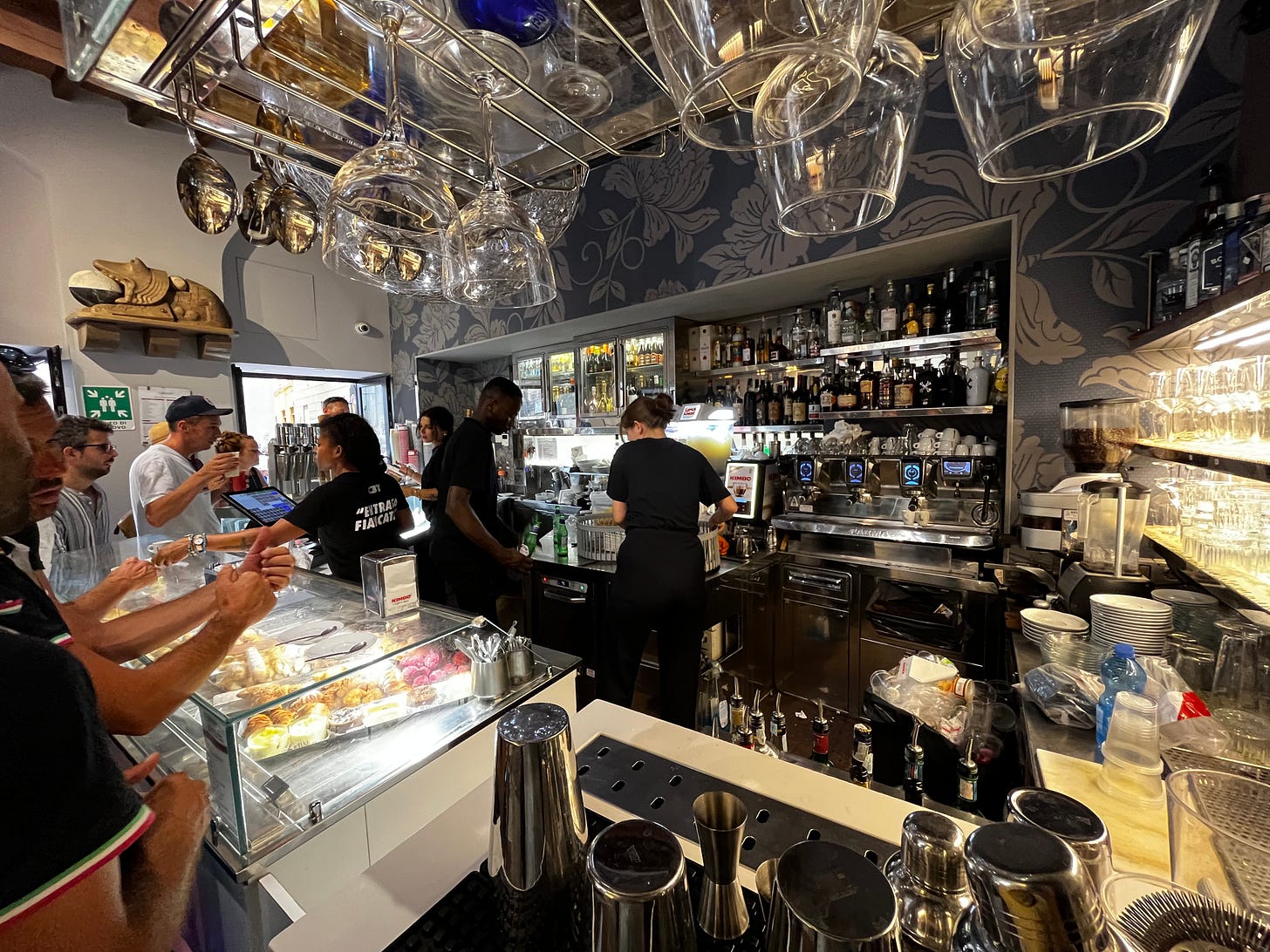



Too bad we won’t get to see it on our next visit. Quite an event. I usually try to avoid crowds but this would certainly qualify for an exception. Great article Tino. Already looking forward to the next one.
Bravo ! Ive lived here 60 years but never had the courage to actually participate in Palio...only going to Siena before or after... each city has its own unique feste, but Siena's palio is perhaps the number 1 !